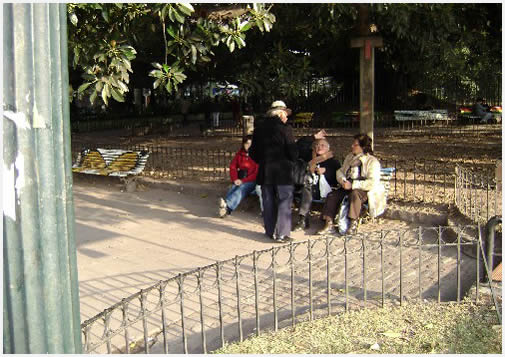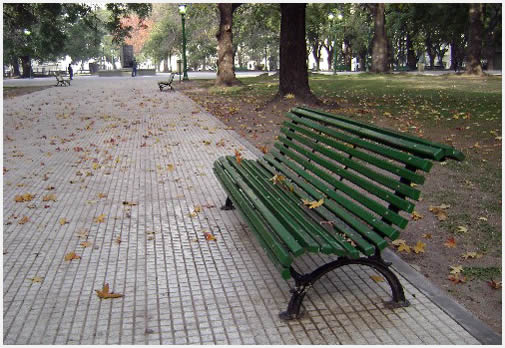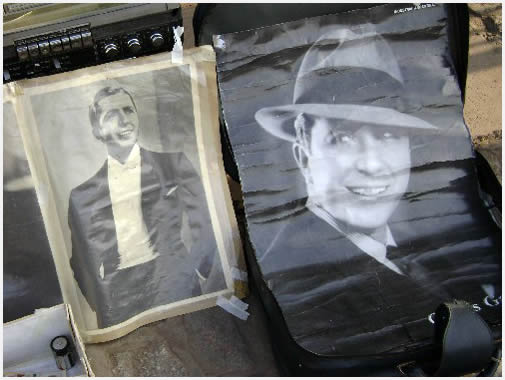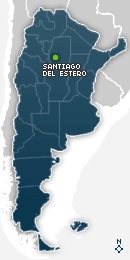 Pablo Etchevers Pablo Etchevers  Pablo Etchevers - Ilustración: Dalmiro Zantleifer Pablo Etchevers - Ilustración: Dalmiro Zantleifer
This great popular artist, whose talent has earned him a privileged place within the Argentinian culture, was born in Añatuya. Known from Santiago to Buenos Aires and from there to the world. |
 |
He was the sixth son of a Uruguayan mother and an Argentinian father. Homero Nicolás Manzione Prestera was born on November 1st, 1907 in Añatuya (or “Añamía”, as he himself used to call it playing with the Spanish words tuya -yours- and mía -mine). It is a place located at about 200 km from the City of Santiago del Estero. Its typical houses of tile roofs and white walls can still be seen today.
This poet spent his first nine years together with his family in one of those homes until his parents decided to send him to the modern city of Buenos Aires to have a promising future. Luis, one of his brothers, would be his guardian and, once settled in the big city, Homero Manzi studied at Colegio Luppi, in the neighborhood of Pompeya. There, he began to show qualities as a writer that would later on turn him into one of the most important popular artists the country has ever seen. Manzi captured those first experiences in the lyrics of wonderful tangos, popular music at a time which, with his help, would end up identifying a whole country.
Man and Politics
Homero Manzi also stood out for his social and political ideas which he brought from his hometown in Santiago and he later polished in his beloved Buenos Aires with celebrities of the time.
Manzi was 19 years old when he began studying at the Law School and he felt deep admiration for José Hernández and Leandro N. Alem, who helped him build his first political ideas and who later on made him lean towards the radical party.
In 1930, after the military coup that overthrew the then president Hipólito Yrigoyen, he led the occupation of the Law School which earned him the expulsion from it. He then began to suffer the prohibition and censorship of his artistic expressions. |
 |
In 1935, together with Arturo Jauretche, Manzi founded Fuerza de Orientación Radical de la Joven Argentina (FORJA), a political movement that during the next decade would support the rising Peronista movement, which would be the continuation of the government of Yrigoyen. Even though Manzi never became a member of the peronismo, he shared the popular and national vision of the political movement.
His passion for tango
Luis motivated his brother to devote himself to literature. He was one of the first people to notice Homero’s gift that allowed him to write naturally. Even though Manzi never published a poetry book, in 1921 he had already written the beautiful waltz ¿Por qué no me besas? (Why don't you kiss me?), which years later would be conducted by the great bandoneón player Anibal Troilo.
Thirteen years later, this unforgettable poet of popular music which blends in his great talent with a strong nostalgic touch full of metaphors took the name of "Homero Manzi", which would immortalize him. |
 |
In those years, together with piano player and composer Sebastián Piana, he was able to reappraise the milonga genre thanks to the composition of famous “Milonga sentimental” and ”Milonga del 900”, among others.
In 1948, he became chairman of the Sindicato Argentino de Autores y Compositores (SADAIC) (Argentinian Guild of Authors and Composers) while taking his first steps in drama, writing in magazines and composing his last and outstanding work “Sur” and “Che”, which later on became music hymns and reflected the identity of Buenos Aires.
Homero Manzi passed away at his early 47 years of age on May 3rd, 1951. He suffered from cancer. At present, small Añatuya as well as the City of Santiago del Estero praise him as one of their most valued sons. |
|
Welcome Argentina - People & Characters in Santiago del Estero
© 2003-2025 Total or partial reproduction forbidden. Derechos de Autor 675246 Ley 11723
|



| |

To the southeast of Santiago del Estero, within the Department of Añatuya, there lies one of the most beautiful natural paradises in the province: the Marshland of Añatuya. A place worth visiting.
|
|

|


